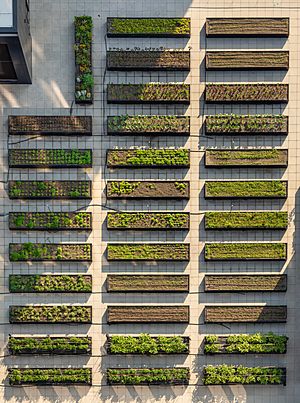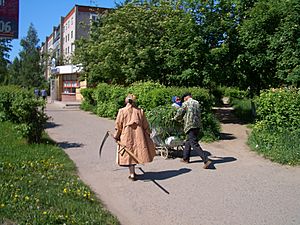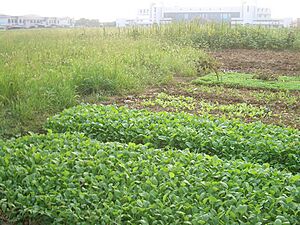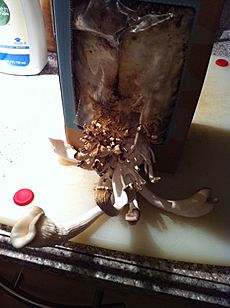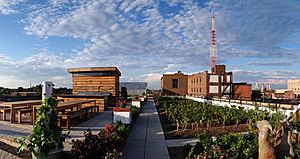Urban agriculture facts for kids

Urban agriculture is all about growing, processing, and sharing food right in our cities and towns. It's not just about plants! It also includes raising animals, aquaculture (farming fish or other water creatures), keeping bees, and horticulture (gardening) in city areas. This is different from "peri-urban agriculture," which happens in the countryside just outside cities.
Urban agriculture can look different depending on where you are. Some people do it because they love organic food and want to connect with nature and their community. They might even be part of a "transition town" movement, trying to make cities more sustainable. For others, it's about making sure they have enough healthy food to eat and even earning some money. No matter the reason, growing food in the city means fresher vegetables, fruits, and even meat, which helps everyone eat better and safer food.
Contents
History of City Farming
People have been farming in cities for a very long time! Some of the earliest examples come from ancient Mesopotamia, around 3500 BC. Farmers there would set aside small areas inside city walls just for growing food.
In ancient Persia, towns in dry areas used special water channels called aqueducts to bring mountain water to their "oases." These oases were like green islands where they grew lots of food, even using waste from the communities to help the plants grow. In the famous city of Machu Picchu, people designed their city to save and reuse water. They also made vegetable gardens that caught a lot of sun, helping plants grow for longer.
The idea of growing extra food, beyond what comes from big farms or far away, isn't new. It became very important during wars and tough economic times when food was scarce. For example, in the early 1800s, "Allotment gardens" started in Germany to help poor people get food.
In 1893, during a tough time in Detroit, the mayor, Hazen S. Pingree, asked people to use empty lots to grow vegetables. These were called "Pingree's Potato Patches." The idea was to help people earn money, get food, and feel more independent. Later, during World War I and World War II, "Victory gardens" popped up all over the US, Canada, and the UK. Citizens grew fruits, vegetables, and herbs to help reduce the pressure on food production, so more food could go to support the war effort.
During World War I, President Woodrow Wilson asked all Americans to grow food wherever they could. Europe was busy with the war and couldn't send much food to the US. So, a new plan was made to feed Americans and even send extra food to other countries. By 1919, over 5 million gardens were growing food, and people harvested more than 500 million pounds of produce!
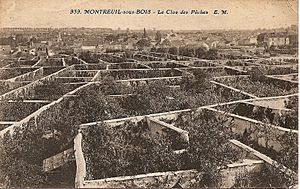
A similar thing happened during the Great Depression. These gardens gave people a purpose, a job, and food when they had nothing. They helped lift spirits and boost the economy. Over $2.8 million worth of food came from these gardens. By World War II, the government even started a National Victory Garden Program to help set up farming in cities. About 5.5 million Americans joined the movement, growing over nine billion pounds of fruits and vegetables a year. That was 44% of all US-grown produce at the time!
Types of Urban Farms
There isn't one perfect name for all the places where food is grown in cities. But we can think of them mainly as gardens and farms. A "farm" usually means a place that sells a certain amount of farm products, but in cities, any plot where food is grown can be called an urban farm. Size doesn't really matter; it's more about growing your own produce in your personal space.
Community Gardens
Many cities offer community gardening spaces where people can grow plants for food, fun, and learning. These are often small plots of land or even rooftops. Community gardens let people learn about growing plants by trying things out. They also help feed people in the community who need food. It's a great way to learn and help others. Seattle's P-Patch program is a good example. The idea of permaculture, which is about working with nature to create sustainable systems, has also helped urban agriculture grow around the world.
City Farms
City farms or urban farms are places in cities where people work with animals and plants to produce food. They are often run by communities to build relationships and teach city dwellers about agriculture and farming. Even though they're called "urban," these farms can be in a backyard or on the roof of an apartment building. They are super important for making sure many communities around the world have enough food.
City farms can be small plots in private yards or larger farms covering several acres. In 1996, a United Nations report guessed that over 800 million people worldwide grow food and raise animals in cities! While some city farms have paid workers, most rely a lot on volunteers. Some are even run completely by volunteers or work with local governments.
One of the first city farms started in 1972 in London. It had farm animals and gardening space, inspired by children's farms in the Netherlands. More city farms then opened across the UK. In Australia, the Collingwood Children's Farm in Melbourne started in 1979 on land that has been farmed since 1838!
In 2010, New York City got the world's largest privately owned rooftop farm. An even bigger one opened in 2012. These were helped by city programs that supported green roofs. In Singapore, you can find hydroponic rooftop farms that grow plants in water instead of soil. These farms also use vertical farming, growing plants in tall stacks. The goal is to make good, pesticide-free food and help people who might not have jobs.
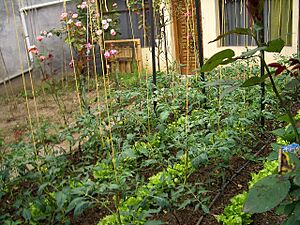
Why Urban Agriculture Matters
Urban agriculture is important for many reasons, including how it uses resources, helps the environment, and makes sure people have enough food.
Resources and Money
The Urban Agriculture Network describes urban agriculture as an industry that grows, processes, and sells food and other products. It meets the daily needs of people in cities. It often uses smart ways to grow a lot of food in small spaces, reusing natural resources and city waste. This helps with food security, health, jobs, and the environment for everyone.
As more people move to cities, getting food can be harder than in rural areas. This especially affects poorer communities. Not having enough food or healthy food can lead to health problems. Urban agriculture can help by making food more available and affordable.
Today, many cities have empty land because of urban growth or empty homes. This land could be used to grow food. One study in Cleveland showed that the city could grow all the fresh produce it needs! This would save a lot of money each year. Using rooftop space in New York City could also provide twice the space needed to grow green vegetables. We could even grow more food using hydroponics or indoor farms. To make these projects happen, they need money from private companies or the government.
Helping the Environment
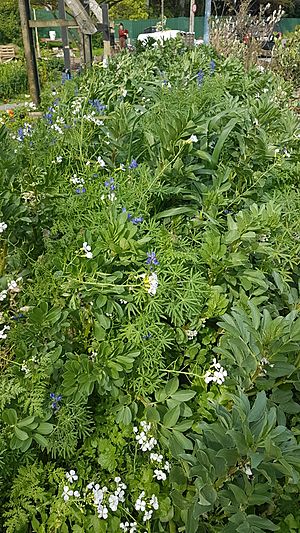
Urban agriculture also helps the environment. It can clean up polluted areas and offer fun outdoor activities. This fits well with modern plans to build sustainable cities.
Urban farms give people, especially those in cities, a chance to get involved with nature. By connecting with how food is made, community gardens teach people how to work together. When residents take active roles in the farm, it works best.
Food Security for All
Food security means that everyone in a community can always get healthy, culturally appropriate food from local, non-emergency sources. Cities often have limited food choices, with many people relying on highly processed fast food or convenience store items. These foods are often high in calories but low in nutrients, which can lead to health issues like diabetes.
These problems have led to the idea of food justice. This means making sure everyone has access to healthy, affordable food, especially in areas where there might be unfairness due to race or income. Urban agriculture is a big part of this solution.
Urban agriculture is part of a bigger conversation about finding new ways to grow food. It helps solve problems like not having enough food, fresh food being hard to get, and unfair practices in the food system. Many different groups, from people who don't have enough food to farmers and community leaders, are leading this discussion.
The ideas of food justice and food sovereignty are also linked to urban agriculture. Food sovereignty means that communities have control over their own food systems, from growing to processing and selling. It focuses on fair decision-making and meeting the community's needs.
Agroecology: Farming with Nature
Agroecology is a way of farming that uses scientific knowledge, traditional wisdom, and community action. It aims to create food systems that are sustainable, fair, and healthy for farmers and consumers. It's all about working with nature and making sure everyone has a say.
With an agroecological approach, urban agriculture can be a "public space," a way to boost the economy, and a tool for community organizing. All while helping to solve food shortages.
Impact of Urban Farming
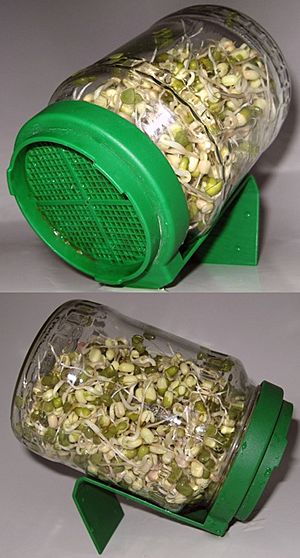
Urban and peri-urban agriculture (UPA) helps make food available, especially fresh produce. It creates jobs and income, and it can improve food security and nutrition for people living in cities.
Economic Benefits
UPA helps the city's economy by producing, processing, packaging, and selling food. This creates new businesses and jobs. It also lowers food costs and improves food quality. UPA gives jobs, income, and access to food for city people, which helps with ongoing and emergency food shortages. Research shows that a community garden plot can produce between $200 and $500 worth of vegetables each year!
Social Connections
Urban agriculture can greatly improve how people feel and interact. It helps with overall community health. Urban gardens are often places where people meet and connect, which makes communities stronger. Many gardens help improve social networks in the neighborhoods where they are located. For many areas, gardens become a "symbolic focus," making people proud of their neighborhood.
When people work together in urban agriculture, they often get more physical activity. This can even boost happiness, like exercising at a gym. Walking or biking to the gardens adds to the physical activity and the benefits of being outdoors.
UPA can improve the livelihood of people living in and around cities. It's often seen as an informal activity, but in many cities where getting food is a constant problem, urban agriculture has been a great way to help. Because UA provides food security, people often feel more independent and empowered. Being able to grow your own food can also boost self-esteem. Families and small communities use empty land to help feed themselves and their city.
For example, growing your own chickens on an urban farm can give you fresh eggs for a very low cost. This allows families to earn more money by selling to local grocers or markets, while also getting fresh, healthy food for their own homes. The popularity of farmers markets has also helped increase income for urban farmers.
Some community urban farms are very efficient and help women find work, especially those who might struggle to find jobs elsewhere. Studies show that women's participation often leads to higher food production, meaning more for the household and more to sell.
Many UA activities happen on empty city land. This has raised questions about who owns the land. Organizations like the IDRC and the FAO are working with city governments to create good rules for urban agriculture.
Over a third of US households, about 42 million, grow food in gardens. More young people (millennials) are also getting into farming. Community gardening has tripled in participation. Urban agriculture brings different communities together. It also gives healthcare providers a chance to connect with their patients. Each community garden can become a hub that reflects the community it serves.
Saving Energy
Our current industrial agriculture system uses a lot of energy to transport food. A study found that the average store-bought produce item travels about 1,500 miles! This uses a lot of fuel and creates pollution. When urban agriculture provides cities with local food, it cuts down on this transportation energy. Local food systems use much less fuel and create less pollution than traditional systems.
For example, one study estimated that switching to locally grown food could save as much pollution as taking nearly 50,000 metric tons of carbon dioxide out of the air, or like taking 16,191 cars off the road!
Reducing Carbon Footprint
Urban agriculture helps reduce a city's carbon footprint by cutting down on how much food needs to be transported. City farms can act like "carbon sinks," absorbing some of the carbon pollution that cities create. Plants take in carbon dioxide (CO2) from the air and release oxygen (O2) through photosynthesis. Choosing plants that stay green all year can help even more.
Cleaner Air
Urban farms can help reduce ozone and other tiny particles in the air, which is good for human health. Reducing these pollutants can lower health problems in cities. A study found that a rooftop with grass could remove a lot of tiny particles from the air. One square meter of green roof can even offset the yearly particle pollution from a car!
Cleaning Up Soil
Empty city lots are sometimes used for illegal dumping of chemicals and waste. They can also collect dirty standing water. Using urban agriculture in these lots can be a cheap way to remove these chemicals. This process is called Phytoremediation. Special plants and tiny organisms are chosen for their ability to break down, absorb, or change toxins in the soil. They can target heavy metals like lead, and other harmful compounds.
Phytoremediation is good for the environment, cheap, and saves energy. It costs much less to clean soil this way than other methods. It also means less contaminated soil needs to be thrown away in special landfills.
Using plants to clean up pollution can stop chemicals from spreading into the surrounding environment. Other cleaning methods often stir up the soil, releasing chemicals into the air or water. Plants can remove chemicals and also hold the soil, preventing erosion of contaminated areas. It's important to note that plants used for cleaning contaminated soil are generally *not* grown for human consumption. They are there to make the land safe again.
One way to check soil pollution is by using certain plants as "bioindicators" of soil health. These are well-studied plants that show how healthy the soil is. Urban soil often has had its topsoil removed, making it hard for air and water to move through. Measuring things like microbial activity and soil organic matter helps check soil health. A new measurement, active carbon, shows the most usable part of the soil's organic carbon, which is important for the soil food web. Using common, well-studied crops as bioindicators can help test the quality of an urban farming plot before planting.
Less Noise Pollution
Loud noise pollution can be annoying and even harmful to hearing and health. Studies show that constant noise is a public health problem. It can lead to hearing problems, heart issues, sleep problems, and lower school performance. Most roofs and empty lots have hard, flat surfaces that reflect sound. Adding plants can absorb these sound waves, leading to a big reduction in noise pollution.
Better Nutrition and Food Quality
Eating a variety of fruits and vegetables every day helps reduce the risk of diseases like diabetes, heart disease, and cancer. Urban agriculture is linked to eating more fruits and vegetables. It's a cost-effective way to get fresh, quality produce to city residents.
Produce from urban gardens often tastes better and is more appealing than store-bought food, which can encourage people to eat more of it. A study in Flint, Michigan, found that people who participated in community gardens ate fruits and vegetables 1.4 times more per day! Garden-based education can also help children eat healthier.
Harvesting fruits and vegetables starts a process where nutrients can break down, especially water-soluble vitamins like vitamin C. But harvesting from your own community garden cuts down on storage time, keeping more nutrients in the food.
Urban agriculture also provides good nutrition for families with lower incomes. Studies show that for every $1 invested in a community garden, you get $6 worth of vegetables! Many urban gardens help food banks by donating extra produce. Programs like WIC and SNAP have even partnered with urban gardens to make fresh produce more accessible in exchange for a few hours of volunteer gardening work.
Urban farming has been shown to improve health. Gardeners eat twice as many fruits and vegetables as non-gardeners. Physical activity also increases with urban farming. These benefits are also linked to social involvement in the community. This social involvement makes neighborhoods look nicer and boosts community spirit. Focusing on community relationships and beauty, not just how much food is grown, helps urban farms have the best positive effect on a neighborhood.
Smart Use of Space
Using high-density urban farming, like vertical farms or stacked greenhouses, can bring many environmental benefits to a city. These systems not only provide food but can also turn wastewater into clean water and recycle organic waste into energy and nutrients. They can also reduce food transportation to a minimum, providing fresh food for many people in almost any climate.
Fairness in Health and Food
A 2009 report found that people in low-income and minority areas often have poor access to healthy food. This leads to health problems like obesity and diabetes. These "food deserts" are often a result of unfair systems. Urban agriculture can help make food access more equal for everyone.
When urban agriculture provides locally grown fresh produce at affordable prices in food deserts, healthy food becomes available to more people, not just those in wealthy areas. This creates more fairness between rich and poor neighborhoods.
Having better access to food through urban agriculture can also reduce stress in poorer communities. Community members learn more about healthy eating. Urban agriculture can also improve mental health. Buying and selling quality products locally helps community members support each other, which can reduce stress. So, urban agriculture can help improve conditions in communities where people feel less control over their lives.
Environmental Justice
Urban agriculture can help achieve environmental justice and food justice for communities in food deserts. It can reduce differences in access to healthy food based on race and income.
Improved food access through urban agriculture can also help people feel less stressed. Community members learn about healthy eating. Urban agriculture can also improve mental health. When people buy and sell local products, they support each other, which can reduce stress.
Urban agriculture can make communities more livable, especially in areas that lack supermarkets due to job losses. Urban farmers who use sustainable methods can build local food systems and improve air, water, and soil quality. Urban farming acts as a green space, improving air quality. A study on a rooftop farm showed that air pollution was 7-33% lower in the farming area. When food is grown locally, it doesn't need to be transported, which reduces CO2 emissions and other pollutants that cause health problems like asthma in poorer areas.
However, urban agriculture can also have risks if the soil is contaminated. Lead contamination is common in city soils from old paint or car exhaust. Without proper education on safe practices, eating food grown in contaminated soil can cause health issues.
City greening goals can sometimes conflict. For example, planting many trees for shade might not be good for vegetable gardens. But some cities are encouraging fruit-bearing trees in parks and on streets to meet both greening and food goals.
How Urban Agriculture Works
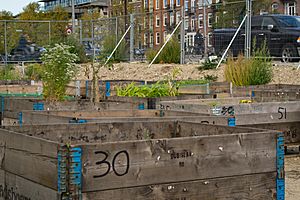
Creating urban agriculture means setting up local ways to grow, process, and get food from farmers to people.
To help grow food, cities have started community farming projects. Some projects have shared community farms on common land, like the old Boston Common. The Collingwood Children's Farm in Melbourne, Australia, is one example. Other projects use the allotment garden model, where gardeners take care of their own small plots in a larger area, often sharing tools. Seattle's P-Patch Gardens use this model. Independent urban gardeners also grow food in their yards and on roofs. Garden sharing projects connect people who want to grow food with people who have extra yard space. Roof gardens let city dwellers have green spaces without needing empty land. Rooftop farms use unused industrial roof space, creating jobs and profit. Projects worldwide aim to make cities "continuous productive landscapes" by using empty urban land and creating temporary or permanent kitchen gardens.
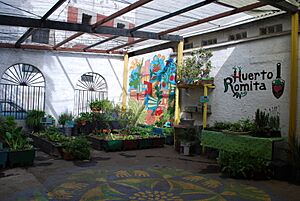

Food processing at a community level is helped by sharing resources like tool sheds and processing facilities. The Garden Resource Program Collaborative in Detroit has tool banks in different areas of the city. Gardeners can share tools, compost, mulch, seeds, and get education. This program also connects gardeners through workshops and events. In Brazil, "Cities Without Hunger" has a public plan to turn abandoned areas into food production sites, improving green spaces.
Farmers' markets, like the one in Los Angeles, are common places where farmers can sell their products directly to people. Big cities often have farmers' markets open on weekends and one day during the week. For example, the farmers' market in Paris is open on Sundays and Thursdays. To make people rely more on urban agriculture and help farmers make a living, markets would need to be open regularly. The Los Angeles Farmers' Market is open seven days a week and connects many local grocers. Its central location helps different sellers reach their customers.
Benefits of Urban Farming
Urban agriculture brings many good things to cities that use it. It helps cities become more sustainable, improves health, and helps reduce poverty.
- UPA helps close the "open-loop" system in cities, where food comes from far away and waste goes out of the city.
- Dirty water and organic waste can be turned into resources for growing food. Wastewater can be used for irrigation, and organic waste can become fertilizer.
- Empty urban areas can be used to grow food.
- Other natural resources can be saved. Using wastewater for irrigation saves fresh water for drinking.
- UPA can help protect natural areas from being turned into farmland.
- Urban agriculture saves energy (like the energy used to transport food from rural areas to cities).
- Growing food locally also saves money on transportation, storage, and lost products, which lowers food costs.
- UPA improves the city environment by adding green spaces and reducing pollution.
- Urban agriculture also makes the city a healthier place to live by improving the environment.
- UPA is a great way to fight hunger and malnutrition because it makes food easier to get for poorer city residents.
- Many people involved in urban agriculture are the urban poor. In developing countries, most urban farm products are for eating at home, with extra being sold. Poor city consumers spend a lot of their money on food, so higher food prices hurt them a lot.
- UPA provides food and saves money on household food costs, leaving more money for other things.
- Extra UPA products can be sold in local markets, earning more money for the urban poor.
Community centers and gardens teach people to see agriculture as an important part of city life. The Florida House Institute for Sustainable Development in Sarasota, Florida, is a public center where people can learn about sustainable ideas. Community centers like this give urban areas a place to learn about urban agriculture and how to make it part of city living.
Urban farms are also a proven way to teach kids about healthy eating and being physically active.
Challenges of Urban Farming
While urban agriculture has many benefits, it also has some challenges:
- Space in cities is expensive and hard to find.
- Using untreated wastewater for irrigation can spread diseases.
- Even though urban gardens can improve air quality, increased pollution (like from more cars) can lead to more insect pests that eat plants. This means less food for people.
- Studies show that the quality of some crops, like wheat, can suffer when grown in areas with high air pollution. This is a big problem in developing countries where pollution is high and many people rely on urban agriculture for food.
- Farming on land that is contaminated (for example, with lead) can be risky for human health. This includes risks from working on the land and from eating food grown in contaminated soil.
City policies for green spaces can sometimes conflict. For example, policies that promote planting many trees might not be good for vegetable gardens because trees create a lot of shade. However, some cities are encouraging fruit-bearing trees to meet both greening and food production goals.
See also
 In Spanish: Agricultura urbana para niños
In Spanish: Agricultura urbana para niños
- Allotment (gardening)
- Asset-based community development
- Building-integrated agriculture
- Ecological sanitation
- Foodscaping
- Forest gardening
- Green wall
- Growbag
- Growroom
- Guerrilla gardening
- Market garden
- Metropolitan agriculture
- Permaculture
- Rooftop gardens
- Satoyama
- Sheet mulching
- Smallholding
- Subsistence agriculture
- Terraces (agriculture)
- Underground farming
- Urban horticulture
- Urban forestry
- Vertical farming
- Windowfarm



